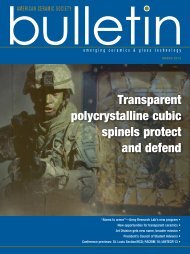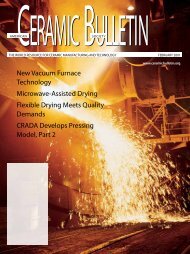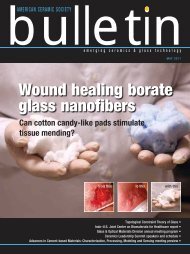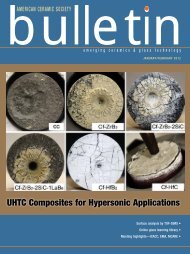AMERICAN CERAMIC SOCIETY
AMERICAN CERAMIC SOCIETY
AMERICAN CERAMIC SOCIETY
You also want an ePaper? Increase the reach of your titles
YUMPU automatically turns print PDFs into web optimized ePapers that Google loves.
X-ray of artificial knee implant.<br />
improved the spatial structure of the<br />
material—but not enough to eliminate<br />
all fatigue wear. They hit on a wellperforming<br />
cartilage sample when they<br />
doused the mix with a gamma radiation<br />
burst. They says this irradiated combination<br />
breaks the main polymer chains<br />
without disrupting the overall structure<br />
of the artificial cartilage. The free radicals<br />
are recrosslinked, improving the<br />
mechanical and tribological properties<br />
of the materials.<br />
According to a news release, the<br />
group believes the irradiated cartilage<br />
composite “could toughen up plastic<br />
joints in joint replacement surgeries<br />
and make them strong enough to last<br />
for years.”<br />
The release continues, “As a result<br />
of the gamma burst, there is no way for<br />
microscopic fractures to be propagated<br />
throughout the material because there<br />
are no long stretches of polymer.”<br />
Xue and others in the group say the<br />
composite has an advantage on alter-<br />
American Ceramic Society Bulletin, Vol. 90, No. 9 | www.ceramics.org<br />
(Credit: F. Jacquot; Wikipedia.)<br />
native artificial joint coatings, such as<br />
nylon and nonstick polymers, because<br />
the polymers produce debris that ultimately<br />
causes inflammation and pain.<br />
They also believe the composite is<br />
more “biocompatible” and may be a<br />
good host for the of addition of bonegenerating<br />
cells.<br />
The work was published in a paper<br />
in the International Journal of Biomedical<br />
Engineering and Technology (doi:0.1504/<br />
IJBET.2011.042495). n<br />
The fuzzy line between biology<br />
and materials science: Using<br />
DNA to build new materials<br />
In an interesting twist on designing<br />
and engineering materials, a group at<br />
New York University led by Paul M.<br />
Chaikin and Nadrian C. Seeman, has<br />
demonstrated that DNA can be used to<br />
assemble complex new materials that<br />
are not necessarily organic.<br />
According to a NYU news release<br />
the NYU scientists created artificial<br />
DNA “tile motifs,” which are short,<br />
nanometer-scale arrangements of DNA.<br />
In the group’s novel approach each<br />
tile serves as a letter— say an “A” or<br />
a “B”—that recognizes and binds to<br />
complementary letters A’ or B’. This<br />
parallels the natural world’s DNA replication<br />
process, where complementary<br />
matches between bases-adenine (A)<br />
pairs with thymine (T) and guanine<br />
(G) pairs with cytosine (C)—to form<br />
its familiar double helix.<br />
However, the NYU researchers take<br />
the DNA a big step farther. Their tile<br />
motif, called BTX (bent triple helix<br />
molecules, each containing three DNA<br />
double helices) differs from ordinary<br />
DNA in a major feature: The BTX<br />
code is not limited to just four letters.<br />
In principle, the BTX motif-based code<br />
can contain quadrillions of different<br />
letters and tiles that combine—still in<br />
pairs—to form a six-helix bundle.<br />
To begin the self-replication of the<br />
BTX tile arrays, the researchers create<br />
a “seed” word to begin to catalyze multiple<br />
generations of identical arrays. In<br />
the work reported in a recent issue of<br />
Nature (doi:10.1038/nature10500), the<br />
NYU group used a BTX seed that consisted<br />
of a sequence of seven tiles, or in<br />
their terminology, a seven-letter “word.”<br />
The self-replication process begins<br />
with placing the seed in a chemical<br />
solution, where it assembles complementary<br />
tiles to form a “daughter BTX<br />
array”— i.e., a complementary word.<br />
The daughter array then is separated<br />
from the seed by heating the solution to<br />
approximately 40°C. The process then<br />
is repeated. The daughter array binds<br />
with its complementary tiles to form a<br />
“granddaughter array.” It is the granddaughter<br />
arrays that represent the self-<br />
NYU scientists have developed artificial structures consisting of triple helix molecules<br />
containing three DNA double helices that can self-replicate. In the above illustration, two<br />
BTX domains are paired by two lateral connections (another two existing connections are<br />
not shown). The cross-section view shows two of the four helices that are formed by the<br />
lateral cohesive interactions.<br />
(Credit: Paul Chaikin, Nadrian Seeman; Nature.)<br />
21






